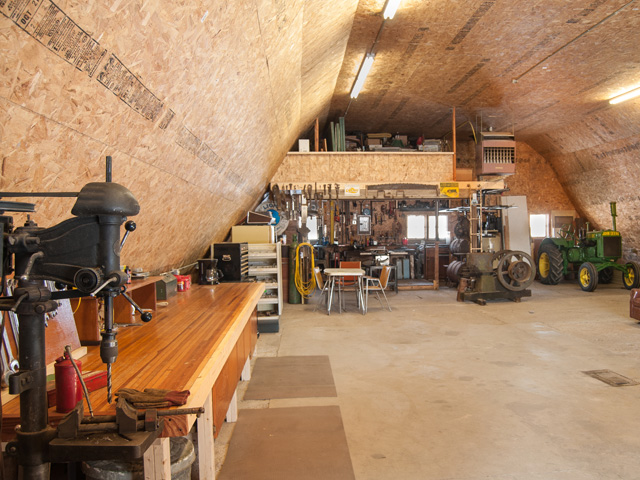America's Great Shops: Old Is New Again
Shop Collapse Led to Rebuilding it Better Than Ever
Larry Crowder shared dozens of cups of coffee with Clinton Krause who often lamented the severe deterioration of the Quonset-style building he had built for his trucking business in 1966.
The building, just off a rutted gravel road at the edge of Bowdon, North Dakota, had been bought and sold several times during the years. Decades of tough Dakota weather and a lack of repair had taken a hard toll. The 36-by-56-foot structure sagged 4 feet in the middle.
But Crowder saw there was good potential in renewal. He was looking for a warm shop to repair equipment and feed his tractor-restoration habit. (See the video story at: https://www.dtnpf.com/…)
Larry and his wife, Pauline, decided to buy the building. Crowder planned to lift the center of the building, pull the sides of the building back into place and replace the rotted sills.
DISASTER FALLS
The repair list soon grew. Five days after purchasing the shop, the weakened roof collapsed under a half-foot of wet spring snow. Most of the rest of the building went down with it. "You've got to be kidding me," Crowder recalled thinking. But there was a "phoenix" ready to rise out of that rubble. "The collapse forced me to build it back better," Crowder said.
He figured the only thing salvageable was the concrete floor. But as Crowder began to dig through the rubble, he discovered some of the curved rafters weren't badly damaged. Each was built from laminated wood. Crowder found he could remove damaged pieces without too much effort. Grafting these pieces with lumber recovered from another Quonset building and using the end wall of his building as a pattern, Crowder and a friend recovered 26 strong trusses. With 2-by-4 trusses and plywood gussets for added strength, each rafter used 40 pieces of wood.
PHOENIX RISES
With help from neighbors, the building began to rise again. Crowder used sucker rods laid into cuts across the width of the floor to pull the footings back up to the concrete pad.
P[L1] D[0x0] M[300x250] OOP[F] ADUNIT[] T[]
Reconstruction was steady, if not always quick. But the structure, which had fallen in March, was up again and enclosed by October. Shingles and fiber cement siding were added the next year. Crowder added 6 inches of fiberglass insulation to the ceiling and sides. The interior is sheeted with 7/16-inch oriented strand board.
This recycled building gives Crowder a comfortable and well-lighted space to work. The overhead door at the shop's entrance is 12-feet-tall and 14-feet-wide, and includes a bank of windows that brings natural light into the front of the shop. Four windows, original to the shop, bring sunlight into the back of the building. A propane furnace hangs from the ceiling. Below is a barrel stove where Crowder burns scrap wood.
THE INSIDES
Crowder has divided the shop into efficient work areas. A welding area by the front door includes a portable welding table that can be rolled out onto the shop floor. Wood around the welding area is protected with salvaged sheets of tin.
Opposite the welding area is a vehicle service area. It includes a small bench, tire rack and shelves for lubricants and fluids.
A 16-foot-long workbench is made from a length of recovered bowling alley -- it is laminated lumber, 3 inches thick and 42 inches wide. Four-plug outlets ring the shop. To keep the outlets perpendicular to the floor, wooden wedges push the electrical boxes outward from the curved walls.
The back of the shop includes a repair and work area, and storage for parts and tools. Overhead is a small 14- x 16-foot loft. Crowder used an old vinyl U.S. Link billboard sign to section off space for sandblasting.
THE MERICKEL MIRACLE
Krause saw the building restored before he died at age 97.
Crowder recalled a conversation he had with Krause years before. On a day when he was unsure about the ultimate success of the restoration, the two men were taking a break. "He told me that back in 1966, when he first put up the shop, he had bought the lumber from 'Miracle' Lumber, in Wadena, Minnesota," Crowder said. "I was looking for any positive signs at that point, and to me, Miracle Lumber sounded just like what I needed."
A couple of weeks passed, and Krause came to Crowder with a smile on his face. In his hand was the old nail apron he had been wearing. "He had decided to wash the dirty apron and, lo and behold, it said, 'Merickel Lumber' right across the front."
It was the push Crowder needed.
"It was quite a thrill to see the shop take shape again," he said. "It's a very nice space to work. Even though it seemed like a disaster when the building fell, the end result was good."
**
Editor's Note:
This is one in a series of America's Best Shops. If you have a farm shop you'd like us to feature, send a note to: dan.miller@dtn.com. If we publish your shop story, we'll pay you $500.
Follow him on Twitter @DMillerPF
(c) Copyright 2021 DTN, LLC. All rights reserved.



